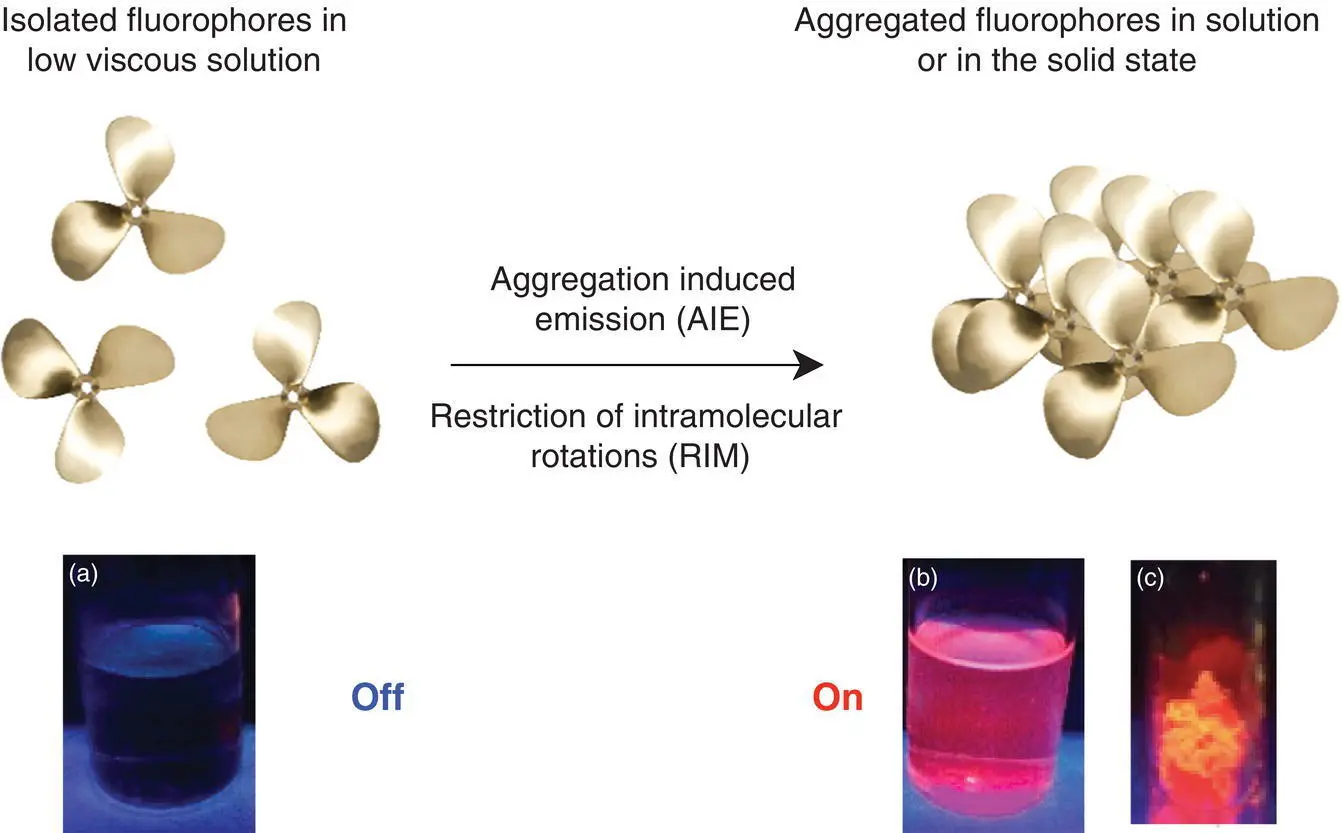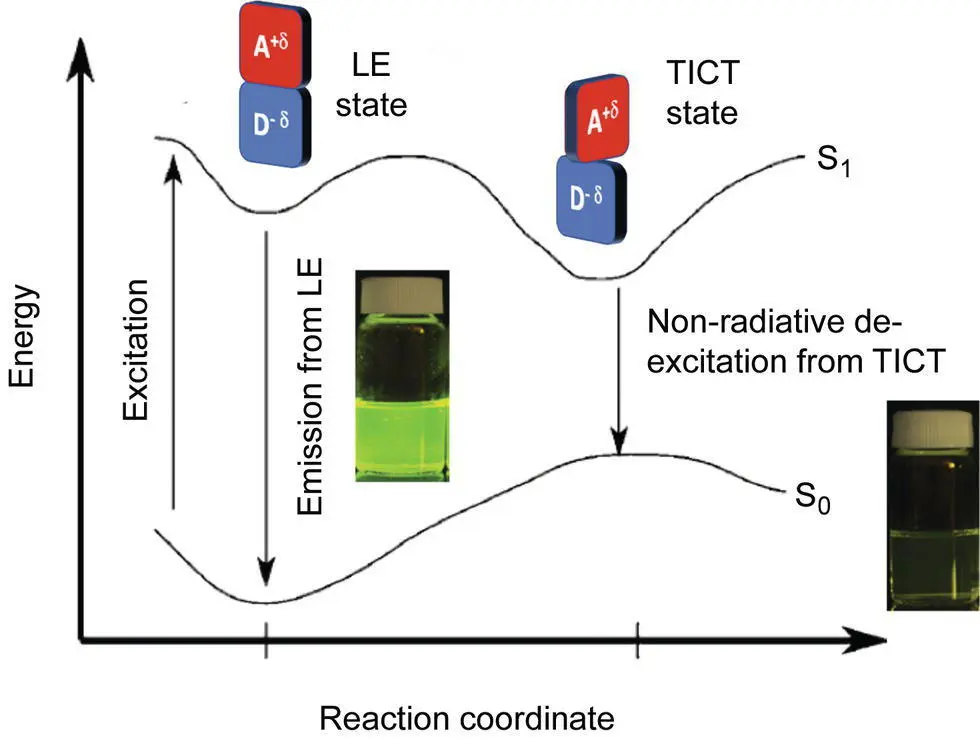3.2 Working Mechanism of AIEgens
As mentioned earlier, the AIE effect arises from the RIMs of propeller‐like fluorophores based on phenyl (or aryl) functional moieties ( Figure 3.2). In the aggregate state, the intramolecular motions that populate the nonradiative de‐excitation pathways are mostly limited; thus, the decrease of the fluorescence intensity would be impeded. Moreover, the propeller shape is then reported to effectively disable the stacking interactions between chromophores, thus limiting the ACQ phenomenon and, in turn, endorsing a bright luminescence in the aggregate and solid states [19, 42].

Figure 3.2 Working principle of the AIE mechanism: nonplanar fluorophores start to emit light by aggregate formation due to the restriction of the intramolecular rotation (RIR) of the multiple phenyl rotors against the stator in the aggregate state. Below are photos taken by exciting a red‐emissive AIE fluorophore: a) in a diluted solution of a good solvent; b) in a solvent–nonsolvent mixture at the same molecular concentration; and c) in the solid state.
Source : Reprinted with permission from Ref. [41]. Copyright (2018) John Wiley and Sons.
The intense luminescence coming from supramolecular aggregates triggered the research also in the field of polymer sensing since the color of the emission was demonstrated to change upon exposing the AIE‐doped polymer films to an external source of energy able to destroy the AIE luminescent assemblies. This process favors the reduction of the barrier energy associated with the AIEgen rotors, thus ending up with the typical ON–OFF behavior. A more attractive OFF–ON behavior is obtained if the external solicitation is provided to kinetically trap amorphous conformations of AIEgens with loosely packing patterns. In this case, if a process of crystallization can be induced for the AIEgens, the emission will be enhanced due to more effective molecular interactions. It is also reported that these molecular interactions in certain functionalized AIEgens with electron‐withdrawing and ‐donating moieties result in the formation of J‐ or H‐aggregate that are characterized by different luminescence features [22]. Notably, the closer the two or more neighboring molecules are, the stronger the intermolecular π – π interactions among them and also exciton coupling and orbital overlap between chromophores. This also makes the generation of excimers (excited dimers) favorable, whose fluorescence is characterized by an unstructured emission at a lower energy than the corresponding monomer fluorescence, thus reflecting on the overall optical properties of solid aggregates. It is worth noting that the color modulation associated with the different donor–acceptor moieties allows for the preparation of diverse emitting AIEgens starting from the same conjugated central core, therefore composing a complete reservoir of highly emissive fluorophores.
It has also been reported that in certain AIE systems with donor–acceptor moieties, the emission characteristics are often addressed to the formation of an equilibrium between a nonemissive twisted intramolecular charge transfer (TICT) state that occurs in solution and a strongly emissive locally excited (LE) state, which is favored in aggregates or in viscous media ( Figure 3.3) [43–46]. Therefore, such AIEgens appear highly luminescent when the molecular rotations are arrested, thus rendering the transformation from the LE to the TICT state unfavorable. Those molecules, also called as fluorescent molecular rotors (FMRs), have become popular in the last decade due to their facile applicability as viscosity sensors and local microviscosity imaging [43, 47]. Also, it has been reported that the formation of the TICT state is governed by the polarity of the environment. Notably, in apolar dispersing media, the planar conformation of the LE state is stabilized by electronic conjugation, therefore yielding an intense fluorescence. Conversely, by changing the polarity of the environment, the LE state is promptly converted into the nonemissive TICT state, where a total charge separation between the donor and the acceptor units of the fluorophore occurs.

Figure 3.3 Potential energy diagram for generic FMRs and the respective emissions in a highly viscous environment that favors radiative de‐excitation from the LE state and in a low viscous solvent that promotes the formation of the TICT state.
Photographs were taken from solutions containing the same FMR molar concentration.
These FMRs are therefore useful for optical sensing applications, e.g. when a chemical stimulus such as the exposure to VOCs determines a change of either the polarity or the viscosity of the polymer matrix, thus effectively providing a clear change of the emission feature of the embedded FMR [46, 48, 49]. More than that, if the polymer matrix is completely apolar such as the majority of the commodity plastics, this would be helpful in maximizing the fluorescence intensity of the rotor, the emission from the LE state being highly favored. Many applications such as those in the energy field would certainly benefit from such a feature.
3.3 AIE‐doped Polymer Films for Optical Sensing
In the introduction chapter, it was already reported that polymer films are the best candidate to promote the AIE technology also in the field of sensing. Notably, AIE polymers have many advantages over low‐mass AIEgens, such as processability, easy functionalization, good thermal stability, and possessing structural complexity and phase ordering that can be easily modulated by external solicitations [29, 30, 50]. The plastic matrix of the films actually allowed a prompt response to external solicitations such as a mechanical, a thermal, or a chemical solicitation by transferring the energy associated with the stimulus to the AIEgen molecules embedded in the film. Optical sensing is what we can define as the property of a traditional device to detect events and provide a corresponding optical output. A “good” optical sensor has to provide a fast change in optical response under stimuli of its environment by coming back to the pristine state in short time and by completely recovering the starting energy level. This is true if a reversible response is desirable or in the case of a reusable device. Quite often, in order to determine an external solicitation that could affect the structural integrity of a material, an irreversible optical response is highly advisable. This is, for example, the case of optical sensors based on doped polymer films utilized in smart and intelligent packaging, i.e. to monitor potential external contamination that could affect and deteriorate the quality of the contained object, most often food. According to the nature of the AIE aggregates in a poorly emissive amorphous or highly luminescent crystalline states, an OFF–ON or ON–OFF optical response can be obtained. In the following paragraphs, examples from the literature are provided in terms of the preparation and characterization of AIE‐doped polymer films as optical sensors able to detect mechanical stress (i.e. called mechanochromic) [16, 51], thermal solicitations (i.e. called thermochromic) [52], and the exposure toward VOCs (i.e. called vapochromic) [53].
3.3.1 Mechanochromic AIE‐doped Polymer Films
Mechanochromic AIEgens show sensitive photophysical response to external stimulation, manifested in their emission color, intensity, as well as the lifetime. The underlying reason is the change in their molecular packing, conformation, and intermolecular interaction induced by the external forces. AIEgens are enabled to act as fluorescent probes to visualize the structural and morphological variations occurred in materials due to any possible contamination event that possibly changes the extent of their aggregation. On this account, AIEgens have been effectively utilized as mechanochromic fluorescent additives in commodity polymers [54] and first attempts for the detection of mechanical stimuli via an ON–OFF optical output are summarized below.
Читать дальше














